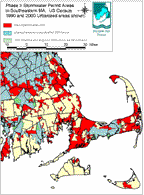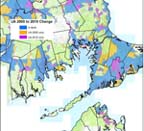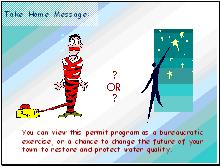Municipal MS4 Permit and Stormwater Management (Phase II NPDES)
Urbanized areas Redefined in the 2010 US Census data
As a result of both changes in methodology and new development, the Urbanized Areas in the 2010 Census changed from the 2000 Census. The map below shows the currently defined urbanized areas. This ArcView shapefile of the 2010 shapefile of urbanized areas of Massachusetts (5 MB zipped) has more details if you have the mapping program, or use open the kml files in the panel below right if you have Google Earth installed on your computer.
2010 Urbanized area map
New EPA 2017 municipal stormwater permits
In 2016, the US EPA published in the Federal Register, a new draft small Municipal Separate Storm Sewer System (MS4) general permit for public comment. The permit was approved and takes effect in July 2017. The new permit covers stormwater discharges from urbanized areas of all Buzzards Bay communities. The new permit, which replaces the first permit issued in 2003, is described at this EPA MS4 permit website.
Municipalities may find some of the new requirements challenging to implement, especially with tight fiscal budgets, so priorities will need to be set. Among the challenges to be met by municipalities in their new Stormwater Management Program (SWMP), they must implement stormwater outfall monitoring programs, and develop strategies to meet bacteria and nitrogen Total Maximum Daily Loads (TMDLs).
Five great reasons why towns should map their stormwater drainage systems
– If there is a hazardous material spill on a road, the fire department will know where those materials will end up.
– If a pond or river is affected by stormwater pollution, towns can be establish priorities for treating the most problematic discharges.
– Understanding stormwater drainage networks can help the better protect well recharge areas for public water supply wells and meet pollution TMDL limits.
– Having a digital map database makes it easier for the town to add or modify the information, track the maintenance of stormwater collection and treatment systems, and better manage their infrastructure.
– They have to

Click to expand the Phase II 1990 vs 2000 map

Click to expand the Phase II 2000 vs 2010 map
Recent Town Phase II MS4 Annual Reports
Acushnet 2009 report
Bourne 2013 report
Carver 2013 report
Dartmouth 2013 report
Fairhaven 2013 report
Falmouth 2013 report
Marion 2013 report Mattapoisett 2013 report
New Bedford 2013 report
Plymouth 2013 report
Rochestor 2013 report
Wareham 2013 report
Westport 2013 report
EPA’s webpage with all municipal annual reports and NOIs.
Background on the EPA-DEP Phase II Stormwater Permit Program
In the past two decades, there have dramatic regulatory changes in how stormwater is regulated. Some of the most important changes began on December 8, 1999, when EPA published in the Federal Register the “Phase II Final Rule” for the National Pollution Discharge Elimination System (NPDES) program. The rule expanded jurisdiction of who must file permits for stormwater discharges in the NPDES “point source” pollution permit program. In 1992, Phase I of the program required for the first time the permitting of stormwater discharges to federal wetlands. In Phase II of the program, permit coverage expanded to include storm water discharges from:
“Certain regulated small municipal separate storm sewer systems (MS4s); and Construction activity disturbing between 1 and 5 acres of land (i.e., small construction activities)” and “revises the ‘no exposure’ exclusion and the temporary exemption for certain industrial activities.”
In plain English, the rule required municipalities to submit permit applications for their road stormwater discharges, as well as “industrial facilities” like DPW garages, waste transfer stations, landfills, and sewage treatment plants (separate from the wastewater discharge permit).
In Massachusetts, the US EPA is the permit issuing authority for federal NPDES permits (that is, Massachusetts is not a “delegated” state).
The 2003 federal Phase II NPDES MS4 stormwater permit required municipalities to develop and implement stormwater management plans (SWMPs). Most notably, it required that towns form stormwater management committees, DPW’s map their stormwater discharge pipes and implement good housekeeping practices, and town boards (like planning boards) update their stormwater regulations to meet the needs of the program and the town’s new stormwater plan. The 2010 permit requires towns to map the entire subsurface stormwater drainage networks, monitor and test stormwater discharges, develop strategies to comply with TMDLs, and requires municipalities establish priorities for the treatment of stormwater discharges.
What is required for MS4 stormwater permits?
In 2003, the US EPA’s NPDES program began requiring that municipalities within urbanized areas obtain stormwater discharge permits to better manage their publicly owned stormwater collection and discharge systems from town roads and properties. The objective of these newly issued water quality permits (called the Phase II MS4 permits), is to minimize the impacts to water quality and wetlands from these municipally owned stormwater discharge systems. The 5-year permits issued to the town under this program requires that the towns develop a Stormwater Management Program (SWMP) to identify stormwater discharges, identify illicit discharges of contaminants to stormwater, and to implement programs and practices to reduce the discharge of pollutants.
The new permits, which took effect in 2017, build upon elements of the 2003 permit and new requirements include implementing stormwater outfall monitoring programs, and developing strategies to meet bacteria and nitrogen Total Maximum Daily Loads (TMDLs). All Buzzards Bay municipalities applied for and received a permit under 2003 permit. The Phase II permits will continue under the old program until the new general permit is finalized by EPA in 2014. Go to EPA’s MS4 permit website for more information on the new permit and to these SWMP guidance documents page for more information on developing SWMPs.
Municipal SWMP annual reports are due each May
Under the old permit, and under the new permit, municipal SWMP annual reports are due each year, describing progress by the municipality (in the 2003, they were required on May 1 of each year). Buzzards Bay municipalities must submit annual reports summarizing municipal progress on implementing their Phase II stormwater management plans. Reports must be submitted both to EPA-NE and DEP. Links to EPA’s sample reports, forms, and other information can be found at www.epa.gov/NE/npdes/stormwater/ms4-annual-rpt.html. In the past, EPA has issued fines to municipalities who failed to submit comply with the program.
One of the more important tasks in each municipal stormwater management plan (under the first permit) is to form a committee composed of representatives from the DPW, planning board, conservation commission, and selectmen, and that they periodically meet to develop complimentary strategies for managing their municipal stormwater systems in their urbanized areas. Municipal officials will find these EPA guidance documents helpful. Sample reporting format is also contained on the following EPA Region 1 stormwater website.
Municipal coordinators with questions may contact Linda Domizio, Division of Watershed Management, MA Department of Environmental Protection, 627 Main Street, 2nd Floor, Worcester, MA 01608, Tel: 508-849-4005, Fax: 508-791-4131, or Thelma Murphy of the US EPA at 617-918-1615, email: murphy.thelma@epa.gov.
General Construction Permit reissued July 2008
EPA’s Construction General Permit was first published in the Federal Register on July 1, 2003 and was reissued July 2008. The permit regulates all construction activity covering one acre or larger, including cumulative impacts of projects segmented over time. Construction sites that are five acres or larger were regulated previously under Phase I of the program and earlier construction general permits promulgated several years ago. Under this Permit, construction site operators or developers in Massachusetts (and elsewhere) will need to develop and implement stormwater pollution prevention plans and file a “Notice of Intent” form at least 7 days prior to initiation of land-disturbing activities. More information can be obtained at the US EPA website on Construction General Permits . While municipalities are not required to ensure that developers are complying with this federal permit program, EPA hopes that municipal Stormwater Management Programs will somehow ensure compliance.
Original Permit Application Delays and Legal Wrangling
The implementation of the original Phase II NPDES program was delayed for a number of reasons. One issue was that the US Census Bureau’s redefined the criteria for “urbanized areas” in the 2000 Census. Because urbanized areas were the basis of whether or not a municipality had to comply with the program, many communities learned for the first time in September 2002 that they must comply with the program by May 2003. In the Buzzards Bay watershed, all 15 mainland municipalities had to submit a Phase II MS4 permit, but nine of these municipalities, (Mattapoisett, Marion, Rochester Wareham, Carver, Middleborough, Plymouth, Bourne, and Falmouth), were added to the program in late 2002.
EPA did not release the draft Phase II MS4 permit until September 2002, with a projected final permit guidance to be issued on December 8, 2002. However, the draft permit raised several questions, requiring EPA to provide additional guidance. Certain issues took a long time to resolve, and the final permit forms were delayed until the May 2003. This caused a rescheduling of the application deadline until July 30, 2003. The final permit, released at that time and still in effect, can be viewed at: https://www3.epa.gov/region1/npdes/permits/permit_final_ms4.pdf. Ironically, if municipalities had submitted a Notice of Intent (NOI) to DEP and EPA before the May 1, 2003 publication of the final permit guidance, it was considered not valid, and they were asked to resubmit a new application signed after the May 1st. The delays by EPA on the issuance of the permit were actually due in part to a 9th Circuit Court decision, which affirmed EPA legal authority to require Phase II permits, but also required meaningful review of the applications. Read this March 7, 2003 California newspaper article explaining the case.

Buzzards Bay NEP Technical Assistance
To assist municipalities in the development of their original permits, the BBP collected the essential information (such as stormwater discharge locations in our Stormwater Atlas) to make municipal Stormwater Management Programs a success, and mailed that information to them on CDs and established this web page. Today the BBNEP continues to assist municipalties in the mapping and evaluation of stormwater networks throughout the watershed, and helping towns adopt effective stormwater regulations.
Application Process
Municipalities have to submit new MS4 permit applications (called a Notice of Intent or NOI) to both DEP and EPA. Both agencies jointly issue the Phase II stormwater permit, and DEP issues the companion 404 water quality certification. DEP and EPA jointly developed a common the NOI permit application form that meets both agency submission requirements. .
Your Stormwater Management Program
The Stormwater Management Program plans submitted in 2003 were in essence a “living document” that needed to be enhanced and refined over its lifetime. The new permit will require expansion of the SWMPs into monitoring programs and TMDL compliance. In many respects, the town’s NOI application is an ongoing commitment to develop and implement a municipal stormwater management program.
The municipal stormwater committees developed under the first permit typically included representatives of the Planning Board, Conservation Commission, Board of Health, Board of Selectman or Mayor’s office, the Building Inspector, and interested citizens. This group will continue to meet to guide the development and implementation of the updated municipal stormwater program to meet the new permit.
Who Does What?
In most Buzzards Bay towns, the breakdown of responsibility for actions in the stormwater management program will vary, but most typically will be as follows:
- The DPW will map storm drain networks and catch basins
- The Board of Health and DPW will detect and remove existing illicit connections to the stormwater system
- The Conservation Commission and Planning Board will better manage future stormwater discharges by amending regulations or proposing new bylaws (if necessary), to ensure adequate stormwater treatment and management to meet the federal permit thresholds (alteration of 1 acre or more of land)
- The Town Administrator will oversee the public outreach requirement and ensure compliance with the Public Meeting laws
- The Board of Selectmen will establish a Stormwater Management Committee of town officials and interested residents to guide and refine the program during the next five years
Municipal Industrial facilities
The Multi-sector General Permit (MSGP) permit for industrial facilities was reissued in May 2008. All DPW “Industrial facilities”, whether or not they are in the Phase II area must file a similar this permit. The application must be supported by a DPW Storm Water Pollution Prevention Plan (SWPPP). This NOI application is required if the stormwater enters a surface water, wetland, other MS4, or conveyance system to a wetland. Check with EPA for the criteria, but the permit may be required for wastewater treatment plants over 1 MGD, waste transfer stations, garages with fueling and washing, salt storage, etc. Municipalities had been exempted from this requirement in the past, but now most municipal facilities were to apply for a MSPG. A separate MSGP permit and SWPPP is required for each facility. Follow this link to theUS EPA Region I Industrial Stormwater permits, who’s covered page (general info for the public and private sectors).
More Background Info:
BBP exclusive: ArcView coverages of Census 1990 vs Census 2000, and Census 2000 vs Census 2010 UAs.
Data from US Census. Coverages include Rhode Island and certain areas adjacent to Massachusetts.
Massachusetts Attorney General’s sample local stormwater bylaw.
The US EPA’s website on the Phase I and II Storm Water programs.
MA DEP’s Phase II Storm Water Information Page.
US EPA page to show detailed maps by town in Massachusetts of Phase II areas, with streets.
Note: All Cape Cod towns and Buzzards Bay towns west to Marion are lumped in the urbanized area for the “Town of Barnstable”. Most other Buzzards Bay towns (Mattapoisett to Dartmouth) are lumped in the map of the New Bedford urbanized area. The Town of Westport is in the Providence, Rhode Island urbanized area. The overview maps are around 300 kb, the detailed road maps are around 1-2 MB.
State and Federal Phase II Contacts
US EPA
Office of Ecosystem Protection, EPA-Region I, Boston, MA
Thelma Murphy, (617) 918-1615
David Gray, (617) 918-1577
Annual reports: Jessica Hing (hing.jessica@epa.gov): (617) 918-1560
MA DEP
Note: MA DEP is not the lead on this permit program,
Fred Civian, MassDEP Boston, 617-292-5821
Municipal Phase II Permit Primary Contacts in the Buzzards Bay Watershed
- Acushnet: Merilee Woodworth, Conservation Agent/ Planning Board Stormwater Agent
- Bourne: William Griffin, Town Manager
- Carver: William Haunen, DPW Director
- Dartmouth: David Hickox, Public Works Assistant Superintendent
- Fairhaven: John Charbenneau, Highway Superintendent
- Fall River: Charles Boulay, Sewer Commission Stormwater Coordinator
- Falmouth: Steven Pisch, Assistant Town Engineer
- Marion: Robert Zora, DPW Director
- Mattapoisett: Michael Gagne, Town Administrator
- Middleborough: Jack Healy, Town Manager
- New Bedford: Ronald Labelle, Director, Water and Sewer Department
- Plymouth: David Gould, Environmental Resources Manager
- Rochester: Laurell Farinon, Conservation Agent
- Wareham: Michael Hartman, Town Administrator
- Westport: Harold Sisson, Highway Surveyor
Please go to our Stormwater Management Page for more information about other programs and initiatives from the Buzzards Bay NEP.